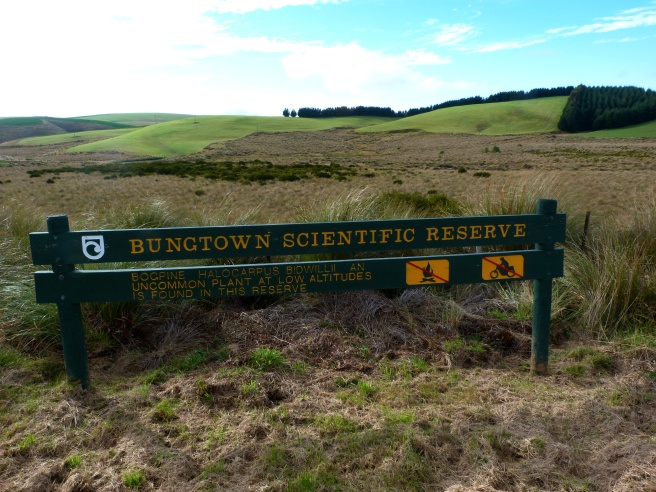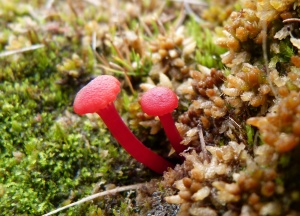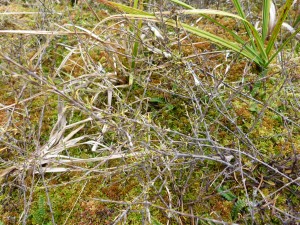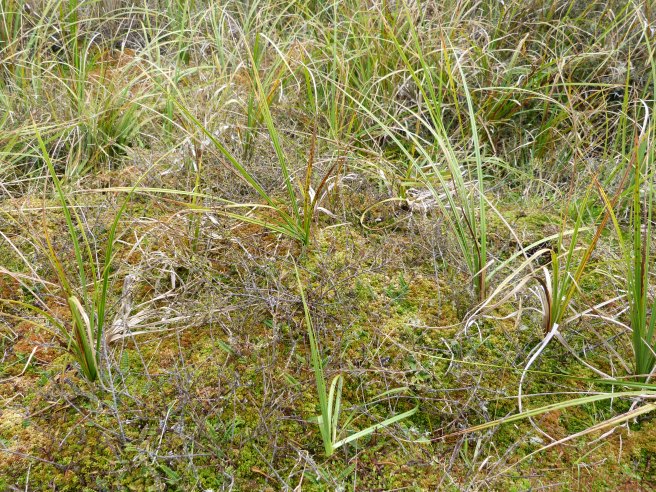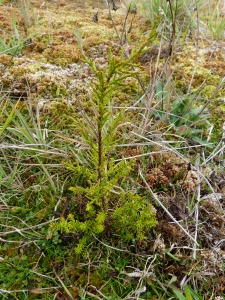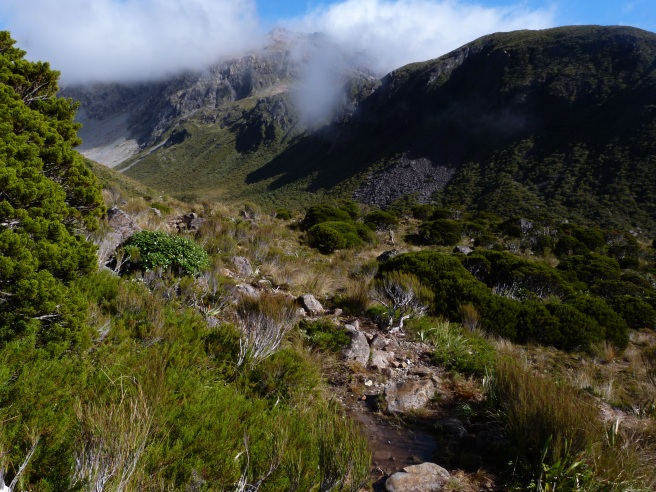What is Bungtown?
Is it where I go when I has too many beersies?
No! Well, kind of, indirectly, ie. when I decide that I must strive to be wholesome, and go on more Saturday morning nerdscursions with other members of the Otago Botanical Society.
Bungtown is a tiny (3.5ha) conservation area in the headwaters of the Waitahuna river, over near Lawrence. I suppose it’s curious name dates back to Bungtown stream’s gold mining heyday – but who knows what sort of noteworthy bunging was going on to justify naming the whole place after it.
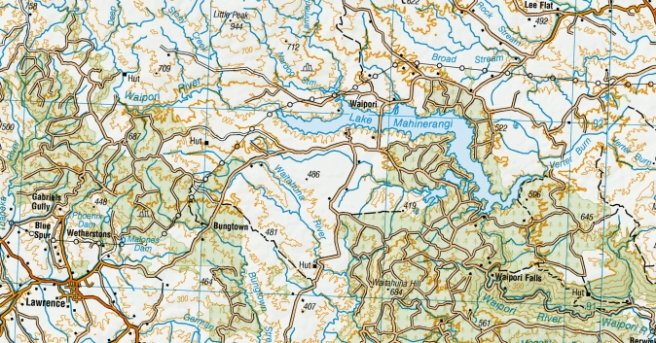
BUNGTOWN!
Why so spesh, apart from it’s delightful name? One reason is that, as you can read from the sign, BOGPINE HALOCARPUS BIDWILLII AN UNCOMMON PLANT AT LOW ALTITUDES IS FOUND IN THIS RESERVE
There is NO time for punctuation when you are in the business of conserving remnants of lowland swamp. NONE.
You can see also in the above picture, behind the sign, most of Bungtown Conservation Area. The reserve boundary is just behind that dark yellowish green blob in the centre. That blob is the stand of Halocarpus. Bungtown bog extends a bit further than just the wee conservation area. According to the Otago Regional Council it is 17.6 hectares of sweet sweet bog. And all around that, predictably, are miles of pine blocks and paddocks.
Sigh etc.
These green, yummy-for-sheep hills would have once been forested with trees like silver beech, podocarps and celery pine. Once the forest was burned, if the land hadn’t been made into farmland, it would have been succeeded by tall tussock grassland.
As it turned out, the hills become paddocks – but Bungtown remains. I am quite glad about this, and these guys would probably agree, if they were into ‘agreeing’ and things like that:
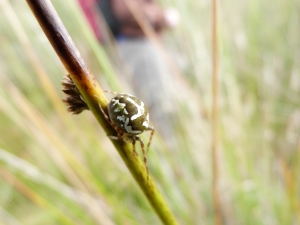
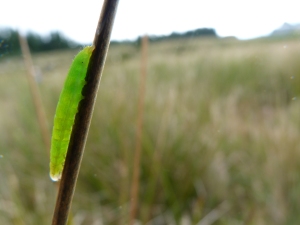
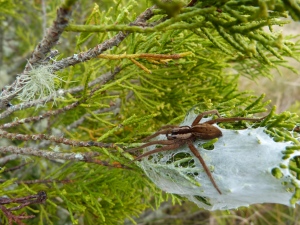
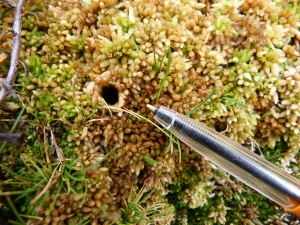
To be precise, and properly feminist – these guys are mostly girls, not guys.
It’s fair to say that Bungtown was teeeeeeming with tiny life; fair crawling with the stuff. You wouldn’t know that at a glance, or even two, so it was good to go for a wander (botanists’ crawl) and poke and squelch and sniff around a bit. The more you see, the more you see….
There was at least one fernbird, but I only heard it. I heard it twice actually, but turned out the first time it was only John Barkla, bird-whispering. Uncanny.
There was some cool fungi about, enjoying the juicy nature of the bog, and lots of mosses, lichens and liverworts too.
I reckon these brilliant red ones are wax-gill mushrooms. I’ve seen these around a bit, always in highly juicy places.
As for this divine creep ! It’s Fuligo septica – dog’s vomit. It’s a slime mould. 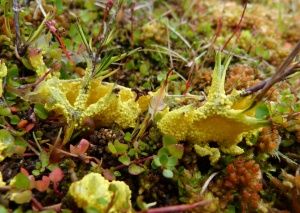
Slime moulds are frikken weird. They are not fungi, or animals, but in a class of their own. In fact, they are in a KINGDOM of their own. They move around and shapeshift and stuff. COMPLETE WEIRDOS.
I was glad to meet old dog’s vomit today. He was actually much more highlighter yellow than it appears in this photograph, I just didn’t know how to make that go into the camera.
I’ll add, a little superfluously, a quote (since John Steel seemed completely untroubled by my suggestion that i might cite him in my nerd blog):
“Fuligo septica: the slime mould you’ll never forget. It’s what got me interested in slime moulds.” – J.S.
Ooh that’s inspiring stuff. I really do hope that we can all find a dog’s vomit in our lives to get us interested in slime moulds. Or whatever it may be for each of us, that ignites a lifelong passion in our souls.
It is unlikely that your lifelong passion will be small-leaved coprosma species, but dammit, I will not ignore them ANY MORE. What coprosmas really need is our caring attention and focus, so we can learn that they are all special snowflakes, worthy of our appreciation and respect.
But, focus and attention can be hard in these times of smertphones and instant gratification. It IS hard for some of us to put down the smartphone, so to aid you in your coprosma ID, how about trying the new, shiney coprosma app! Yup, it’s a thing! (I’m pretty sure you’ll still have to put some studious focus into stipules and leaf hairs to really get the most out of the app). You can use it on android AND iphone, so that’s very egalitarian of them (unlike SOME highly desirable but inaccessible to those who aren’t i-slaves applications *co-naturewatch-ugh* *cou-florafinder-ugh*).
I didn’t spend tooo much time sniffing round the coprosmas on this particular occassion (getting quickly distracted with sticking my camera in neon green glowstick caterpillar’s face) but did ask my wise companions to tell me what the main ones were. So, let’s review the contestants:
Our first bachelor is Coprosma elatrioides. It is found in South Island swamps and bogs, often lurking around with similar characters to who we saw it with at Bungtown: bog pine, sphagnum moss, wire rush and red tussock.
Coprosmas are a little scary to ID because they’re almost all twiggy little shrubs with tiny leaves. However, with any one species, there are only ever a few species that look super super similar, and usually they are found in different habitats. So if you can manage to get your head in the game, a hand lens, and a good field guide or key, they’re not toooo difficult to work out (ok apart from the whole hybridising thing, but let’s not talk about that). Usually I can’t be bothered, so I just ask someone who knows, but chances are you have a little more attention span than I do so you should definitely give it a go. Bring a nerd friend, it’s funner that way (coprosma-focussed nerd friends are hard to find, but when you do they are worth their weight in gold).
Coprosma elatirioides looks a lot like Coprosma intertexta, having similar leaf size and shape, but would you find it at Bungtown? No way, ’cause intertexta lives in dry scrub and grasslands.
Coprosma rugosa looks similar too, but different in the leaf. While C. elatirioides has evenly spread hairs on the surfaces of the leaves, C. rugosa also has hairs on the leaf surfaces, but they are in clumps. Ewww! Bit subtle innit. I’d prefer to distinguish them by the fact that C. rugosa is an erect shrub (as is C. intertexta), whereas our mate the Coprosma elatirioides is prostrate. He hugs the ground, forming mattress-like mounds which can be up to about six metres in diameter. Or sometimes the long flexible branches sprawl around, like this guy’s:
If you’re familiar with the sand coprosma, Coprosma acerosa, you’ll understand that he could also be confused with C. elatirioides. Similar leaf shape and size, and he shares the prostrate plant form – but again they like different habitats. Sand coprosma likes well-drained sites, in coastal areas. Like in the sand. At the beach. Also it always has glabrous leaves – no hairs, scattered or otherwise.
Arggg! I just realised I’m getting completely sucked down the rabbit hole of coprosma talk, and it is probably reeeeeally boring. So, quickly, the other bachelors I saw at Bungtown were good ol’ C. dumosa, and C. cheesemanii. And now no more coprosmas for today, good day coprosmas. I said good day.
(this is not the end. We will be back).
As for the nearest relatives to coprosma – let’s go there.
The nerteras!
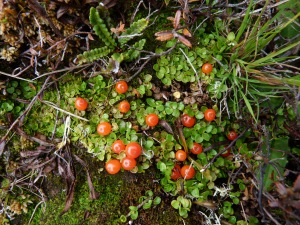
I love nerteras, don’t you? Juicy, friendly (aka relatively common), creeping little groundcovers, with cute round (and presumably edible) berries. And they like hanging out where filmy ferns live, so what’s not to love?
Nertera is a widespread genus of about 15 species, mostly found in Australasia and South America. They are known as ‘bead plant’, for those who are into common names. I prefer to just go with ‘nertera’. It means ‘low growing’ so it is nicely descriptive, and such a cute name too that it could be a contender for a botanist’s baby’s name (maybe just a middle name).
In New Zealand there are eight species of nertera. At Bungtown we came across Nertera depressa, and it was fruiting gloriously. I ate a couple of berries, they weren’t bad. I think there were two seeds in each berry. Unlike some of the other nerteras, the leaves of N. depressa are glabrous. Supposedly when it is bruised, NERdep (can’t resist those six letter species codes sometimes, so get used to it) stanks like Coprosma foetidissima – I couldn’t smell it on this particular occasion though. NERdep is the cutest. It’s found in all the main islands of Aoteoroa (NorthSouthStewartChathamsSubantarctics) as well as in Australia aaaand southern South America. It likes the foreeest, by the coast and in the mountaaaaains, scrubby spots, grassland and the alpine zone, growing all the way up to 1400m. So, you know, it’s around. The places I’ve seen it at it’s most lush and luxuriant, and most abundant and spready, have all been in the forest – you know those really juicy, ferny spots where the moss mosaic is ultra diverse and psychadelic – ooh that’s where it really thrives.
We have some at the Botanic Garden, I have planted it under a Dracophyllum longifolium in a spot that’s a bit shady, a weee bit juicy and ultra well-drained. The native collection doesn’t have many of these sort of areas, it’s usually either shady and dry or sunny and clayey. I dream of having a juicy bit where I can plant all the ferns and such…..
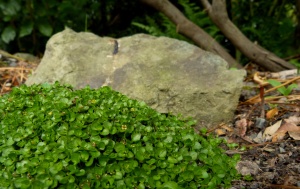
Oh well, you make do (there is still a lot to play with!). My nertera has spread a bit in the few months since I planted it and took this photo, and actually the leaves seem like they have shrunk now – but that could be my imagination.
I get a real bang out of growing my little forest friends in the garden. It’s not the same as seeing them in the wild, but the Botanic Garden is just up the road from a lot of our homes (and it is a pretty great garden) so it’s still really really cool, I say.
I’m sorry this post is so long, but I really must document this trip as an aid for my buggy, forgetful brain – I feel like I owe it to my botanical mentors who let me pick their brains all day to remember at least some of it.
So, onwards!
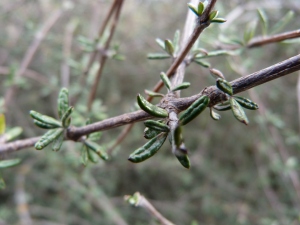
Another shrubby guy that was kicking around with the coprosmas at Bungtown was Olearia bullata – not somebody I’ve come across heeeaps even though it is apparently common in higher spots around Otago. Even it’s type locality is Flagstaff hill. It likes the eastern South Island the best, if the spot is wet enough for it.
Olearia bullata is pretty dang cool I reckon, especially since it’s specific epithet (the ‘bullata’ bit) actually describes it’s leaf morphology, woop! ‘Bullate’ means ‘blistered’, and even though the leaves are mini (less than 1cm mostly), they are definitely blistered and puckered. They are white underneath, and mostly in opposite clusters.
Here’s a picture of the whole bush: a grey, bushy and springy shrub that can grow to about 2m tall:
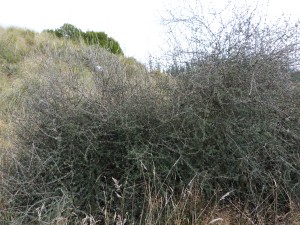
One day I’ll show you a seedling I have planted in my garden at home which is grown from seed from an Olearia bullata that has naturally hybridised with Olearia illicifolia. The leaf characteristics of this plant are intermediate between the two babe parents and maate, she’s dreamy.
Ahem. Moving on. In the interests of posterity (wait, does posterity have interests?) I must do a quick shout out to some of the other plants seen on that day of 28 March 2015 at Bungtown Conservation Area:
Carex coriacea (probably)…not the most exciting plant or even a half decent photo but, there you are.
As vanilla as it may seem, it seems like a good one for me to make acquaintance with, because I come across it quite a bit, especially in soggy patches in farm paddocks. It’s quite common in seepy spots. It’s found throughout the country. It dies down in the winter.
Fun fact: to southern maori it was called matoreha (the settlers, and plenty still, call it cutty grass). It was used for the outer thatch of houses.
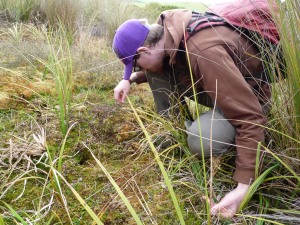 Here DK is checking out a good squelchy patch inhabited by an interesting plant community. There is plenty of sphagnum and other mosses, with hard mounds of the comb sedge Oreobolus strictus, a bit of the ubiquitous Blechnum penna-marina, Gonocarpus aggregatus (in the Haloragis family), the odd Celmisia gracilenta, Androstoma empetrifolia, and even a couple of flavours of sundews (Drosera arcturi and D. spatulata). I’ll chuck a full species list of the area on here once J.S. sends it around.
Here DK is checking out a good squelchy patch inhabited by an interesting plant community. There is plenty of sphagnum and other mosses, with hard mounds of the comb sedge Oreobolus strictus, a bit of the ubiquitous Blechnum penna-marina, Gonocarpus aggregatus (in the Haloragis family), the odd Celmisia gracilenta, Androstoma empetrifolia, and even a couple of flavours of sundews (Drosera arcturi and D. spatulata). I’ll chuck a full species list of the area on here once J.S. sends it around.
Let’s just focus on one more plant, and then wrap this behemoth of a blog post up. I felt I should give a little bit more attention to the bog pine, because I really haven’t got these guys down yet. Bog pine, pink pine, yellow-silver pine, monoao – I’m sure they’re all quite different but I definitely have not got them sorted in my brain yet.
Halocarpus bidwillii, the bog pine, is a small tree or shrub, that grows on poorly drained sites, and just to be confusing, is also known to hang out in tussock grassland and on dry, stony ground. It can be a bit erect, or else spreading in habit. It grows slowly, its smooth greyish brown bark growing fissured with age . Sometimes it’s branches lie along the ground and form roots, which then grow into a wee ring of shrubby bits around the parent.
Halocarpus is an endemic genus to New Zealand. There are three species, bog pine, (H. bidwillii), pink pine (H. biformis), and the exclusively Northern-dwelling manoao (H. kirkii). Bog pine is the smallest – 3.5m tall max, but usually quite small shrubs. Pink pine can get up to 10m tall, and manoao is a tall tree up to 25m in height.
Clearly Halocarpus bidwillii and Halocarpus biformus are the easiest two to get mixed up – even their names are way too similar. They overlap in range, sometimes, too, often growing together and even hybridising. Ewww!
If it happens to be in fruit, you can hopefully tell whether you are looking at a bog pine or a pink pine because the seeds of bog pine have a waxy white coat (aril) at the base, and on the pink pine the arils are yellow to orange.
The habit of a plant, as well as its habitat, can definitely be clues to its identity. You might find yourself in a damp, subalpine forest with a bunch of small, single-trunked trees that look a bit like teenage rimu (‘hammer-marked’ bark, beautiful bonsai-like forms) – but there are no hulking great grown-ups poking out above the canopy, and this isn’t the kind of well-drained, fertile hangout that rimu prefers. (Also, rimu, especially the teenagers, are weeping, spiky, sesame-street looking characters, all droopy and rotund). You might be looking at ye olde pink pine. Bog pine is much more likely to be in open habitats, and is definitely a multi-stemmed shrub, not a single-trunked tree.
All the species of Halocarpus have a well-defined juvenile form, in which the leaves are long, narrow and flat. This develops into an adult form, where the leaves are scale-like, and closely pressed to the stem.
It seems to be a very halocarpus-ey thing to do to then revert back to the juvenile foliage here and there, perhaps zigzagging between the adult and juvenile forms for a long time, until eventually the crown of the mature shrub or tree may only bear adult foliage.
At Bungtown I saw a few little guys like this one, with juvenile foliage at the base and adult foliage at the top – so were they seedlings, or slow-growing tweenagers doing the bonsai thing?
JS told me that he has noticed more of the juvenile (more rimu-like) leaves in the shade sometimes.
That’s all I’m going to focus on with the Halocarpus for today. It was nice to do a spot of reading on these guys (thank you Rob Lucas, John Dawson, NZPCN, and the TERRAIN website) and next time I see a wee bog-loving conifer, maybe I’ll be a bit more open to figuring it out.
(I am pretending that LEPint doesn’t exist for now).
A month or so back I was playing at the beautiful Otira valley (one of my spiritual homelands, not a hippie at all though) and there were quite a few bog pines there. At least I believe these were Halocarpus bidwillii. They are kickin’ it with some Dracos, tussocks and babin’ shrubs like Olearia colensoi and Brachyglottis bidwillii. That is a story for another day. But here is a picture:
I just love that place!
But what I also love is finding wee gems close to my own Dunedin backyard, like Bungtown Conservation Area.
Squelching round in the bog, looking around at the plantsperts around me, I felt very grateful to be a part of this little botanical community. I would really encourage any budding plantspeople to come out on a Saturday excusion with the Botanical Society of Otago – you can read about some of the cool places they’ve checked out in the past at http://www.otago.ac.nz/botany/bso/pastcalendar.php.
As you will see, you have missed out on some cool places, but don’t worry, there are plenty more of sweet trips coming up in 2015. Also on any one of these trips there are going to be at least a couple of real dedicated botanist types, who are very generous with their knowledge. They will answer most of your dumb (or brainy) questions, or you can just follow them round like I do and try and osmose a bit of nutrition from their giant brains.
Fresh, clean blood is always welcome in the Botanical Society, because, as David Lyttle said in our meeting the other day, “we don’t wan’t to senesce”. Hehe. Like a living organism. Like a plant community. Lols. But like we’re not desperate or anything (join our club) only if you want to (join our club). We’re not thaaaaat obsessed with plants (i like hymenophyllums) we also like to have a good time (with hymenophyllums). If you have actually managed to read this far, you definitely should probably be in our club.
Kate, you are just being silly now. Here is a final snap of some invigorated botanists at Bungtown.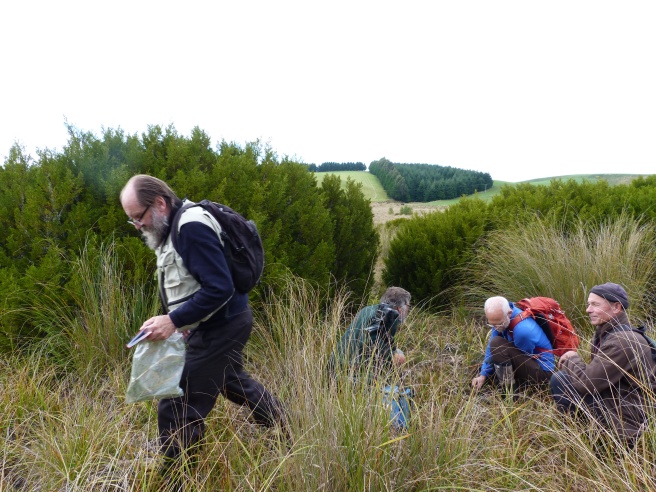
And finally, finally: a species list of everything spotted at Bungtown on the day: Thank you to John Steel (and his contributors) for compiling and sharing this list:
Bungtown Scenic Reserve species list
Thank you for reading. A shorter post next time, I promise.

